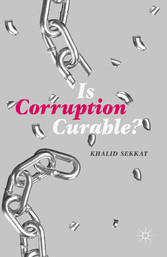Suchen und Finden
Service

Is Corruption Curable?
Khalid Sekkat
Verlag Palgrave Macmillan, 2018
ISBN 9783319985183 , 357 Seiten
Format PDF, OL
Kopierschutz Wasserzeichen
Contents
6
Abbreviations
8
List of Tables
10
Introduction
11
Part I Corruption, Extent, Causes and Consequences
15
1 Definition, Amount, and Coverage
19
1 Definition
19
1.1 Public Officials
20
1.2 Illegality
22
1.3 Payments and Benefits
24
2 Amount
25
3 Coverage
27
4 Politics
28
4.1 Bureaucracy
30
4.2 Justice
33
4.3 Media
35
4.4 Education
38
4.5 Medical
41
4.6 Water
43
5 Conclusion
46
References
47
2 Measurement Issues
52
1 Measurement Issues
53
2 Selected Indicators
55
2.1 Corruption Perceptions Index
55
2.2 International Country Risk Guide
56
2.3 Worldwide Governance Indicators
57
2.4 World Enterprise Surveys
58
2.5 Criticisms
59
2.6 Comparative Analysis of the Indicators
62
3 Perception Versus Experience
66
3.1 Reasons for the Divergence
66
3.2 Evidence of Divergence
68
4 Persistence of Corruption
72
4.1 Evidence of Persistence
74
4.2 Explanations of Persistence: Conceptual Discussion and Empirical Evidence
77
5 Conclusion
80
References
81
3 Causes
83
1 Conceptual Analysis
84
1.1 Characteristics of the Country: Geography and History
84
1.2 Characteristics of Institutions: Democracy, Functioning of Democracy, and Decentralization
86
1.3 Characteristics of the Society and Citizens: Culture, Values, and Gender
88
1.4 Characteristics of the Economy: Regulatory Quality, Economic Competition, and Economic Development
89
1.5 Characteristics of the Corruption System: Systemic Corruption
90
2 Empirical Evidence
91
2.1 Characteristics of the Country: Geography and History
94
2.2 Characteristics of Institutions: Democracy, Functioning of Democracy, and Decentralization
100
2.3 Characteristics of the Society and Citizens: Culture, Values, and Gender
103
2.4 Characteristics of the Economy: Regulatory Quality, Economic Competition, and Economic Development
119
2.5 Characteristics of the Corruption System: Systemic Corruption
122
3 Conclusion
126
References
127
4 Consequences
131
1 Conceptual Analysis
131
1.1 Unconditional Economic Effects
132
1.2 Unconditional Non-economic Effects
135
1.3 Conditional Effects: “Greasing” Versus “Sanding” the Wheels
136
2 Evidence: Economic Effects
140
2.1 Unconditional Effects
141
2.2 Conditional Effects
149
3 Evidence: Non-economic Effects
155
4 Conclusion
165
References
167
Part II Anti-corruption Strategies: The Role of the State
172
5 Democracy
176
1 Expected Impacts of Democracy on Corruption
177
2 Actual Impacts of Democracy on Corruption
178
3 Conclusion
186
References
187
6 Electoral Rules
189
1 Expected Impacts of Electoral Rules on Corruption
190
2 Actual Impacts of Electoral Rules on Corruption
193
3 Conclusion
197
References
198
7 Decentralization
199
1 Expected Impacts of Decentralization on Corruption
200
2 Actual Impacts of Decentralization on Corruption
202
3 Conclusion
209
References
210
8 Regulation
212
1 Expected Impacts of Regulation on Corruption
213
2 Actual Impacts of Regulation on Corruption
214
3 Conclusion
218
References
219
9 Justice
220
1 Expected Impacts of Justice on Corruption: Structural and Procedural Aspects
221
2 Actual Impacts of Justice on Corruption: Structural and Procedural Aspects
223
3 Expected Impacts of Justice on Corruption: Sentencing
229
4 Actual Impacts of Justice on Corruption: Sentencing
233
5 Conclusion
236
References
237
10 Specialized Anti-corruption Agencies
240
1 Expected Impacts of ACAs on Corruption
240
2 Actual Impacts of ACAs on Corruption
243
3 Conclusion
247
References
247
11 Incentives and the Corruption Market
249
1 Expected Impacts on Corruption
250
1.1 Incentives and Wages
250
1.2 Public Service Delivery and the Bureaucrat’s Monopoly
250
1.3 Shifting Service Provision to the Private Sector
251
2 Actual Impacts on Corruption
252
2.1 Incentives and Wages
252
2.2 Public Service Delivery and the Bureaucrat’s Monopoly
260
2.3 Shifting Service Provision to the Private Sector
264
3 Conclusion
270
References
271
12 International Cooperation
273
1 Instruments of International Cooperation
273
1.1 Foreign Corrupt Practices Act (FCPA)
273
1.2 United Nations Convention Against Corruption (UNCAC)
276
1.3 Other Anti-Corruption Initiatives
276
2 The Debate on the Costs and Benefits of These Instruments
277
3 Actual Impacts of International Cooperation
279
4 Conclusion
283
References
284
Part III Anti-corruption Strategies: The Role of Civil Society
286
13 Civil Society and the Media
289
1 Expected Impacts of the Media on Corruption
290
2 Actual Impacts of the Media on Corruption
292
3 Conclusion
302
References
302
14 Civil Society and the Specific Role of ICT
304
1 Expected Impacts of ICT on Corruption
305
2 Actual Impacts of ICT on Corruption
306
3 Conclusion
313
References
314
15 Civil Society and the Role of Education
315
1 Expected Impacts of Education on Corruption
316
1.1 Social Capital and Corruption
316
1.2 Education and Social Capital
318
2 Actual Impacts of Education on Corruption
319
2.1 Social Capital and Corruption
319
2.2 Education and Social Capital
323
2.3 Education and Corruption
328
3 Conclusion
336
References
337
Conclusion
340
Index
344


